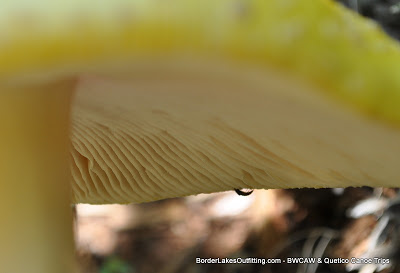
Fly Amanita is the quintessential toadstool we started drawing as kids in elementary school. It’s also known as the “fly mushroom” or “fly poison mushroom” because it is believed a saucer containing Fly Amanita in milk will attract and kill flies.
The young mushroom begins covered in a universal veil and may be misidentified as a Puffball mushroom. As the mushroom grows, the veil breaks apart and its remnants are seen as whitish “scabs” on a bulbous cap. As it continues to mature, the bulbous cap becomes more flat and the white gills are visible on the underside of the cap. When the mushroom reaches maturity, the outer edges of the cap may cup upward.

The Fly Amanita is indigenous to northern Minnesota. It is usually yellow-orange here – in contrast to bright red varieties elsewhere. The cap size ranges from 3 to 10 inches wide, and the white stem grows 3 to 7 inches tall.
They are found growing from the ground – not from trees – from June through September. They are typically found among stands of pines and aspens.
The toxins muscimol and ibotonic acid are contained in Fly Amanita. Ingestion can cause serious internal injury and, in some rare instances, death. They are generally considered poisonous and not edible. However, some report that the toxins may be parboiled out of the fungus, and rumors surround the hallucinogenic effects caused by people eating these dangerous mushrooms. Lore has it that the Vikings of the eleventh and twelfth centuries ingested them and found superhuman strength. And Lewis Carroll, author of Alice in Wonderland, was a known experimenter with drugs. His book illustrations included a white-spotted red mushroom appearing to be Fly Amanita. Another side effect of ingesting Fly Amanita is macropsia – a condition making things appear larger than life size. Sounds like the book, doesn’t it.

I snapped these photos recently on a portage along the Little Isabella River in the BWCAW. During the canoe trip, deer flies buzzed around our heads. It makes me wonder: Might Fly Amanita in a milk concoction work for meddlesome deer flies around camp?

I really enjoyed this entry, I've also seen these along portages and didn't know what they were called.